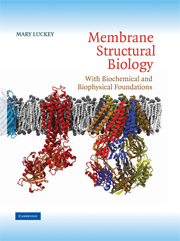Book contents
- Frontmatter
- Contents
- Preface
- 1 Introduction
- 2 The Diversity of Membrane Lipids
- 3 Tools for Studying Membrane Components: Detergents and Model Systems
- 4 Proteins in or at the Bilayer
- 5 Bundles and Barrels
- 6 Functions and Families
- 7 Protein Folding and Biogenesis
- 8 Diffraction and Simulation
- 9 Membrane Enzymes and Transducers
- 10 Transporters and Channels
- 11 Membrane Protein Assemblies
- 12 Themes and Future Directions
- Appendix I Abbreviations
- Appendix II Single-Letter Codes for Amino Acids
- Index
- References
7 - Protein Folding and Biogenesis
- Frontmatter
- Contents
- Preface
- 1 Introduction
- 2 The Diversity of Membrane Lipids
- 3 Tools for Studying Membrane Components: Detergents and Model Systems
- 4 Proteins in or at the Bilayer
- 5 Bundles and Barrels
- 6 Functions and Families
- 7 Protein Folding and Biogenesis
- 8 Diffraction and Simulation
- 9 Membrane Enzymes and Transducers
- 10 Transporters and Channels
- 11 Membrane Protein Assemblies
- 12 Themes and Future Directions
- Appendix I Abbreviations
- Appendix II Single-Letter Codes for Amino Acids
- Index
- References
Summary
With an appreciation of the structural characteristics and functional diversity of membrane proteins, the question of their biogenesis arises. How does a nascent peptide, a chain of amino acids emerging from the ribosome, fold into a three-dimensional structure and insert into the membrane bilayer? Evidence suggests that folding and insertion are coupled processes in cells. However, given the nature and complexity of these processes, different approaches are taken to study folding and insertion in vitro.
Protein folding studies give information about the thermodynamic forces that drive folding and about its kinetic pathways, identifying transient but detectable intermediates. Recently these techniques have been applied to purified membrane proteins of both the α-helical and β-barrel classes. While the folding mechanisms determined by in vitro studies of membrane proteins may differ significantly from mechanisms of their biogenesis in the cell, these studies do provide insights into the necessary steps, as well as their stability and their lipid requirements. Thermodynamic analysis of the in vitro folding process gives insights into the evolution of the complex machinery used to assemble membrane proteins in cells. Finally, the in vitro studies provide valuable practical information on refolding techniques that are applicable to other membrane proteins that have been denatured during purification.
Insertion of nascent proteins into the membrane involves their translocation out of the cytoplasm by the same export machinery used to secrete proteins.
- Type
- Chapter
- Information
- Membrane Structural BiologyWith Biochemical and Biophysical Foundations, pp. 160 - 190Publisher: Cambridge University PressPrint publication year: 2008



